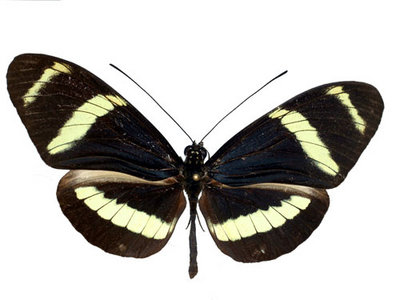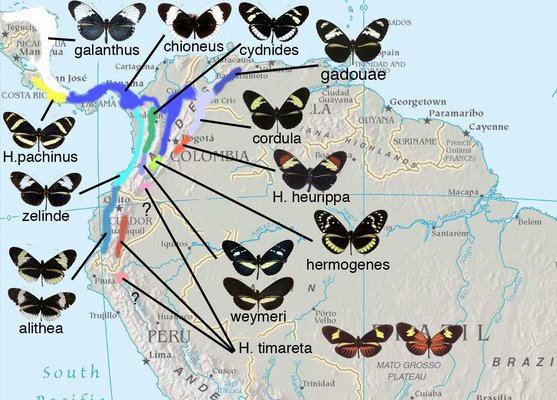Heliconius pachinus
Heliconius cydno pachinus [Lamas (2004) views pachinus as a subspecies of H. cydno]
Margarita Beltrán and Andrew V. Z. BrowerIntroduction
This close relative of Heliconius cydno is endemic to the Pacific slope of Costa Rica and western Panama. It is involved in Müllerian mimicry with H. hewitsoni.
Characteristics
Early stages: Eggs are yellow and approximately 1.6 x 1 mm (h x w). Females usually place eggs singly on growing shoots and tendrils of the host plant. Early instar larvae have a white body and black spines. Mature larvae have a pinkish brown body with black spots, black scoli and the head is orange with two black horns, length is around 1.4 cm. Caterpillars are gregarious in small numbers (Brown, 1981; DeVries, 1997).
Adult: H. pachinus can be distinguished from mimetic H. hewitsoni by the proximal yellow forewing band. In H. pachinus, this band is entirely beyond the end of the discal cell, while in H. hewitsoni, the yellow band cuts through the distal end of the discal cell. H. pachinus lacks the brown "forceps" marking on the underside of the hindwing that occurs in H. cydno forms, and instead exhibits rather extensive red basal streaks, another feature it shares in common with its mimic H. hewistoni.
Geographical Distribution
Heliconius pachinus is distributed on the Pacific slopes of Costa Rica and Panama.

Habits
H. pachinus occurs from sea level to 1,600 m in association with rain forest habitats. Usually individuals fly rapidly and in the lower story. Females mate multiply and adults roost solitarily at night at 2-10 m above ground on twigs or tendrils.
Hostplant: Passiflora costaricensis, P. vitifolia, and many other Passiflora spp (Passifloracea) (DeVries, 1997).
References
Beltrán, M., Jiggins, C. D., Brower, A. V. Z., Bermingham, E. & Mallet, J. 2007 Do pollen feeding, pupal-mating and larval gregariousness have a single origin in Heliconius butterflies? Inferences from multilocus DNA sequence data. Biol. J. Linn. Soc. 92, 221-239.
Brown K. S. 1981 The Biology of Heliconius and Related Genera. Annual Review of Entomology 26, 427-456.
DeVries P. J. 1997 The Butterflies of Costa Rica and Their Natural History, Volume I: Papilionidae, Pieridae, Nymphalidae Princeton University Press, Baskerville, USA.
Lamas, G. (ed.) 2004 Atlas of Neotropical Lepidoptera. Checklist: Part 4A Hesperioidea - Papiionoidea. Gainesville: Scientific Publishers/Association of Tropical Lepidoptera.
Salvin, O. [1835-1898] 1871. Descriptions of new species of butterflies from tropical America. Annals and Magazine of natural History (4)7(42): 412-416.
About This Page

University of Cambridge, Cambridge, UK

Middle Tennessee State University, Murfreesboro, Tennessee, USA
Correspondence regarding this page should be directed to Margarita Beltrán at and Andrew V. Z. Brower at
Page copyright © 2010 and
 Page: Tree of Life
Heliconius pachinus . Heliconius cydno pachinus [Lamas (2004) views pachinus as a subspecies of H. cydno].
Authored by
Margarita Beltrán and Andrew V. Z. Brower.
The TEXT of this page is licensed under the
Creative Commons Attribution-NonCommercial-ShareAlike License - Version 3.0. Note that images and other media
featured on this page are each governed by their own license, and they may or may not be available
for reuse. Click on an image or a media link to access the media data window, which provides the
relevant licensing information. For the general terms and conditions of ToL material reuse and
redistribution, please see the Tree of Life Copyright
Policies.
Page: Tree of Life
Heliconius pachinus . Heliconius cydno pachinus [Lamas (2004) views pachinus as a subspecies of H. cydno].
Authored by
Margarita Beltrán and Andrew V. Z. Brower.
The TEXT of this page is licensed under the
Creative Commons Attribution-NonCommercial-ShareAlike License - Version 3.0. Note that images and other media
featured on this page are each governed by their own license, and they may or may not be available
for reuse. Click on an image or a media link to access the media data window, which provides the
relevant licensing information. For the general terms and conditions of ToL material reuse and
redistribution, please see the Tree of Life Copyright
Policies.
- First online 18 February 2007
- Content changed 04 September 2008
Citing this page:
Beltrán, Margarita and Andrew V. Z. Brower. 2008. Heliconius pachinus . Heliconius cydno pachinus [Lamas (2004) views pachinus as a subspecies of H. cydno]. Version 04 September 2008 (under construction). http://tolweb.org/Heliconius_pachinus/72254/2008.09.04 in The Tree of Life Web Project, http://tolweb.org/









 Go to quick links
Go to quick search
Go to navigation for this section of the ToL site
Go to detailed links for the ToL site
Go to quick links
Go to quick search
Go to navigation for this section of the ToL site
Go to detailed links for the ToL site